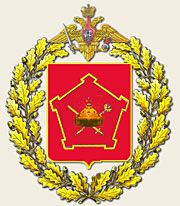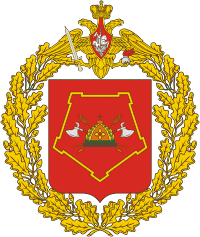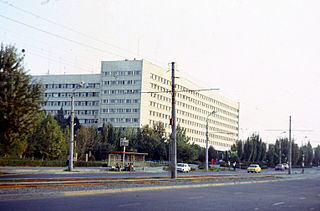Related Research Articles

The Russian 201st Military Base is a Russian military base based in Dushanbe, Tajikistan, part of the Central Military District. It was originally raised twice in World War II as part of the Soviet Union's Red Army and is now part of the Russian Ground Forces.

The Order of Lenin Moscow Military District is a military district of the Armed Forces of the Russian Federation. Originally it was a district of the Imperial Russian Army until the Russian Empire's collapse in 1917. It was then part of the Soviet Armed Forces. The district was awarded the Order of Lenin in 1968. In 2010 it was merged with the Leningrad Military District, the Northern Fleet and the Baltic Fleet to form the new Western Military District. In December 2022, Defense Minister Sergey Shoigu proposed to reestablish it along with the Leningrad Military District, a decision confirmed in June 2023 by Deputy Chief of the General Staff Yevgeny Burdinsky.

The Siberian Military District was a Military district of the Russian Ground Forces. The district was originally formed as a military district of the Russian Empire in 1864. In 1924 it was reformed in the Red Army. After the end of World War II the district was split into the Western and Eastern Siberian Military Districts. In 1956 the district was reformed. In 2010 it was divided between the two newly formed Central and Eastern Military Districts.

The Turkestan Military District was a military district of both the Imperial Russian Army and the Soviet Armed Forces, with its headquarters at Tashkent. The District was first created during the 1874 Russian military reform when by order of Minister Dmitry Milyutin the territory of Russia was divided into fourteen military districts. Its first commander was Konstantin Petrovich von Kaufmann, who was also Governor-General of Russian Turkestan at the time.
A rifle corps was a Soviet corps-level military formation during the mid-twentieth century. Rifle corps were made up of a varying number of rifle divisions, although the allocation of three rifle divisions to a rifle corps was common during the latter part of World War II.
The 245th Motor Rifle Division was a division of the Soviet Army and later the Russian Ground Forces, active from 1967 to 1997 and later from 2001 to 2006.
The 1st Shock Army was a field army established by the Soviet Union's Red Army during World War II. The 1st Shock Army was created in late 1941 and fought in the northern areas of Russia and the Baltic States until the surrender of Germany in 1945. The Army was created in accordance with prewar doctrine that called for Shock Armies to 'overcome difficult defensive dispositions in order to create a tactical penetration of sufficient breadth and depth to permit the commitment of mobile formations for deeper exploitation.' However, as the war went on, Shock Armies lost this specific role and reverted, in general, to ordinary frontline formations.

The 108th Nevelskaya Motor Rifle Division, abbreviated as the "108th MRD," was a unit of the Soviet Ground Forces and the Armed Forces of Uzbekistan. It was the successor to the 360th Rifle Division. The division was created in August 1941 by the State Defense Committee and the Volga Military District Commander, Vasily Gerasimenko, in the Volga Military District. The 360th compiled a distinguished record of service during the Great Patriotic War on the northern sector of the Soviet-German front, including the award of a battle honor and the Order of the Red Banner.
The 266th Rifle Division was a rifle division of the Soviet Red Army during World War II. The 266th was formed three times during the war.

The Red Banner Central Asian Military District was a military district of the Soviet Armed Forces, which existed in 1926–1945 and 1969–1989, with its headquarters at Tashkent (1926–1945) and Almaty (1969–1989). By USSR Order No.304 of 4 June 1926, the Turkestan Front was renamed the Central Asian Military District.

The 306th Rifle Division began its combat path under unusual circumstances. It was partly formed for the first time as a standard Red Army rifle division a few months after the German invasion, but the formation process appears to have been abandoned and the unit was never assigned to the front. A second formation began in April 1942 and was completed on June 16, after which it was sent to the Kalinin Front. Assigned to 43rd Army, it remained in that Army until November 1944, and in that Front until March 1945. It ended the war in Leningrad Front, helping to contain the German forces trapped in the Courland Pocket. The division had compiled a solid record of service and won a unique battle honor by this time, and was disbanded shortly after hostilities ended.
The 36th Rifle Division was a division of the Red Army and then the Soviet Army. The division was formed in 1919 as the 36th Rifle Division and fought in the Russian Civil War and the Sino-Soviet conflict of 1929. In 1937 it became the 36th Motorized Division. The division fought in the Battles of Khalkhin Gol. It was converted into a motor rifle division in 1940 and fought in the Soviet invasion of Manchuria in World War II. Postwar, it became a rifle division again before its disbandment in 1956. The division spent almost its entire service in the Soviet Far East.
The 79th Motor Rifle Division was a motorized infantry division of the Soviet Army. It was converted from the 79th Rifle Division in 1957 and inherited the honorific "Sakhalin". The division was awarded the Order of the Red Banner. The 79th Rifle Division fought in the Invasion of South Sakhalin in 1945 and was based at Leonidovo for most of its career.
The 120th Rifle Division was an infantry division of the Red Army, formed three times. Its first formation became the 6th Guards Rifle Division for its actions in the Yelnya Offensive. Its second formation became the 69th Guards Rifle Division for its actions in the Battle of Stalingrad. The division was reformed a third time in late April 1943. It was disbanded "in place" with the Central Group of Forces in the summer of 1945.
The 17th Rifle Corps was a corps of the Red Army and later the Soviet Army, formed three times.
The 265th Motor Rifle Division was a motorized infantry division of the Soviet Army during the Cold War.
The 374th Rifle Division was raised in 1941 as an infantry division of the Red Army, and served for the duration of the Great Patriotic War in that role. It began forming in August 1941 in the Siberian Military District. It joined the fighting front in December with the new 59th Army along the Volkhov River and it continued to serve in the fighting near Leningrad until early 1944. The dismal fighting on this front gave little opportunity for a unit to distinguish itself, and the division did not finally earn a battle honor until late January 1944, during the Leningrad–Novgorod Offensive. It continued to serve in the summer and autumn offensive through the Baltic States, becoming so reduced in strength that its remaining infantry was consolidated into a single understrength regiment which nevertheless won a battle honor in the liberation of Riga. The 374th ended the war in Latvia, helping to contain and reduce the German forces trapped in the Courland Pocket, and was disbanded shortly thereafter.
The 376th Rifle Division was raised in 1941 as an infantry division of the Red Army, and served for the duration of the Great Patriotic War in that role. It began forming in August 1941 in the Siberian Military District. It followed a very similar combat path to that of the 374th Rifle Division. It joined the fighting front in December with the new 59th Army along the Volkhov River and it continued to serve in the battles near Leningrad until early 1944. The division took horrendous casualties in the combat to create and hold open a passage to the 2nd Shock Army during the Lyuban Offensive and was itself partly or fully encircled at several times during this dismal fighting. The division finally left this region as it advanced during the Leningrad–Novgorod Offensive in January 1944 and in July won a battle honor in the liberation of Pskov, while its 1250th Rifle Regiment was awarded the Order of the Red Banner. In October the 376th as a whole would also receive the Red Banner for its part in the liberation of Riga. The division ended the war in Latvia, helping to contain and reduce the German forces trapped in the Courland Pocket, and was reorganized as a rifle brigade shortly thereafter.
References
- Holm, Michael (2015). "33rd Army Corps". www.ww2.dk. Retrieved 2016-05-18.